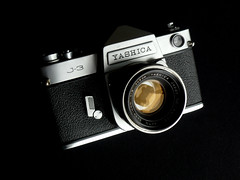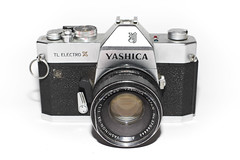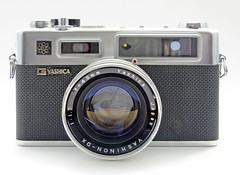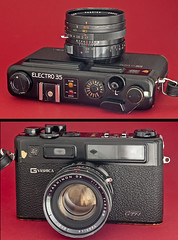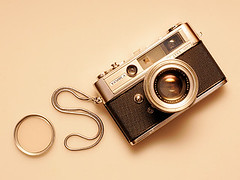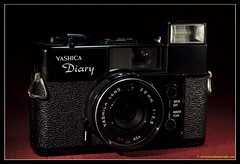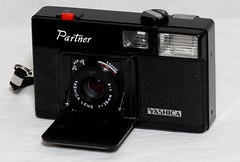Difference between revisions of "Yashica"
(→Links) |
m (→Yashima period: nbsp) |
||
| (152 intermediate revisions by 31 users not shown) | |||
| Line 1: | Line 1: | ||
| + | {{Flickr_image | ||
| + | |image_source= http://www.flickr.com/photos/uberj/4439058075/in/pool-camerawiki | ||
| + | |image= http://farm5.static.flickr.com/4003/4439058075_b745e33f38.jpg | ||
| + | |image_align= right | ||
| + | |image_text= Original Yashica Mat, Lumaxar lenses | ||
| + | |image_by= Jeff Rawdon | ||
| + | |image_rights= with permission | ||
| + | }} | ||
| + | '''Yashica''' was a Japanese camera maker, founded in 1945 and absorbed into [[Kyocera]] in 1983. It notably manufactured 35mm SLR cameras under the [[Contax]] brand from 1974 onwards. | ||
| + | |||
== Company history == | == Company history == | ||
| − | + | === Yashima period === | |
| − | ''' | + | The company was founded in May 1945 as '''Yashima Seiki Seisakusho''' (八洲精機製作所, meaning Yashima Precision Works) in the Nagano Prefecture.<REF name="Sakai 6"> Sakai, p.6 of {{KKS}} no.26. </REF> It first acted as a sub-contractor for other companies, and notably made fuses for gun shells during the last months of World War II.<REF name="Sakai 6" /> After the war's end, it manufactured components for clock or electric equipment makers.<REF name="Sakai 6" /> In December 1949, Yashima became the stock company as '''Yashima Seiki K.K.''' (八洲精機{{kabu}}),<REF name="Sakai 6" /> whose initial equity was ¥170,000.<REF name="Sakai 7"> Sakai, p.7 of {{KKS}} no.26. </REF><REF> A previous unsourced version of this page says that the company had eight employees by the time. </REF> |
| + | |||
| + | In early 1953,<REF> Dates of the earliest advertisements and articles listed for Yashima's Pigeonflex in {{Kokusan}}, p.360. </REF> the company began to make its first camera, the [[Pigeonflex]] 6×6cm TLR, on behalf of the distributor [[Endō|Endō Shashin-yōhin]].<REF name="Sakai 6" /><REF name="Shibano 8"> Shibano, p.8 of {{KKS}} no.26. </REF><REF> ''Kyōshū no burando ten'', p.10. </REF> In June 1953, it changed its name to '''Yashima Kōgaku Seiki K.K.''' (八洲光学精機{{kabu}}, meaning Yashima Optical Precision Instruments),<REF name="Sakai 6" /> reflecting its new involvement into the camera business. The same year, the company marketed its first camera under its own brand, the [[Yashima Flex|Yashima Flex]], another 6×6cm TLR. The Pigeonflex and Yashima Flex were already equipped with [[Tomioka]] lenses, beginning a relationship that would last for years. | ||
| + | |||
| + | The Yashima Flex was very soon succeeded by a number of models named Yashicaflex, some of which had semi-automatic winding. In 1956, the company name was changed to '''Yashima Kōgaku Kōgyō K.K.''' (八洲光学工業{{kabu}}, meaning Yashima Optical Industries).<REF name="Sakai 6" /> The same year, the inexpensive Yashica Rookie made further use of the Yashica brand, which was constructed from <u>Yashi</u>ma and <u>Ca</u>mera, similarly to "Leica", "Konica" and various others. | ||
| − | Yashima | + | In 1957, the Yashima company released the Yashica-Mat with crank advance. The same year, it founded '''Yashica, Inc.''', its first subsidiary outside Japan, based in New York City to manage marketing efforts in the USA.<REF name="Sakai 6" /> It also entered the 8mm cine camera market with the Yashica 8T. |
| − | + | === Yashica from 1958 to 1973 === | |
| + | In 1958, the company became '''K.K. Yashica''' ({{kabu}}ヤシカ, Yashica Co., Ltd.),<REF name="Sakai 6" /><REF name="Shibano 9"> Shibano, p.9 of {{KKS}} no.26. </REF> finally adopting the name of its products. By the time, it had ¥100,000 equity base.<REF name="Sakai 7" /><REF> A previous unsourced version of this page says that the company had 1,982 employees by the time. </REF> It expanded into other segments of the market, releasing the Yashica 35, its first [[35mm film]] camera, and the [[Yashica-44]], a 4×4cm TLR strongly inspired by the [[Baby Rolleiflex (1957)|Baby Rolleiflex]], which caused conflicts with [[Rollei|Franke & Heidecke]].<REF name="Shibano 8" /> Finally, it acquired the company [[Nicca|Nicca Camera]], which was making 35mm cameras with focal-plane shutter and went bankrupt in June 1958.<REF> Lewis, p.104. </REF><REF> A previous unsourced version of this page said that the company also absorbed Zunow in 1960 or 1961, but this was surely a mistake. </REF> | ||
| − | In | + | In 1959, the former [[Nicca]] products were taken over under the Yashica brand with some modifications, the Nicca 33 becoming the [[Yashica YE]] and the Nicca IIIL becoming the [[Yashica YF]]. The Nicca Camera company itself became the subsidiary Taihō Kōgaku K.K. (大邦光学{{kabu}}, meaning Taihō Optical).<REF name="Sakai 6" /> |
| − | + | For some years, the company had ties with the [[Konan|Konan Camera Laboratory]], whose founder Nakamura Gakan trained various Yashica engineers detached for that purpose.<REF> Shirai, pp.61–2 of ''Maboroshi no kamera o otte''. </REF> A direct result of that cooperation was the [[Yashica Future 127]], a prototype camera taking 4×4cm film presented in 1959, and the first Japanese camera with automated exposure. | |
| − | + | Also in 1959, Yashica further diversified into the subminiature market, releasing the [[Yashica Y16]] with a novel system of preloaded cassettes. | |
| − | The | + | The company also established ties with [[Polaroid]], and it released the Japanese made [[Polaroid Pathfinder 120]] in 1960.<REF name="Sakai 6" /><REF name="Shibano 9" /> That year, the company's equity base was ¥600,000, multiplied by six in two years.<REF name="Sakai 7" /> The same year, Yashica also released the [[Yashica Pentamatic|Pentamatic]], a modern 35mm [[SLR]] with specific bayonet-mount interchangeable lenses, capitalizing on Nicca's experience in focal-plane shutters. The proprietary bayonet mount was soon abandoned, and Yashica adopted the popular [[42mm screw lenses|42mm screw mount]] for the 1961 [[Yashica Penta J|Penta J]] and later 35mm SLR models. It is said that all the lenses sold under the Yashikor or Yashinon brands were supplied by [[Tomioka]]. |
| − | In | + | In 1961, Yashica released the [[Yashica Rapide|Rapide]] half-frame camera, having effectively entered all the possible segments of the market (except for medium-format SLRs). It continued to work on auto-exposure cameras, with the [[Yashica Flash-O-Set|Flash-O-Set]] and Yashica 35EE so-called "Electric Eye" cameras. Its first camera with electronically controlled shutter was the Yashica Electro Half, launched in 1965, whose shutter was developed by [[Copal]];<REF name="Shibano 10"> Shibano, p.10 of {{KKS}} no.26. </REF> this was also the first Japanese camera commercially available with an electronic shutter.<REF name="Shibano 10" /><REF> The first cameras in the world with electronically controlled shutter were the Polaroid 100 and the Japanese Artronic prototype, both presented at the 1963 Photokina. (Lewis, p.118.) A previous unsourced version of this page said that the world's first electronically controlled 35mm camera was the Yashica Electro 35, but this is definitely a mistake. </REF> The full-frame Yashica Electro 35 followed in early 1966.<REF name="Shibano 10" /><REF> A previous unsourced version of this page says that 5 million units of the Electro 35 were eventually sold, but this is unconfirmed. </REF> |
| + | In April 1968, the subsidiary Taihō Kōgaku (former Nicca Camera) was merged into the main company,<REF name="Sakai 7" /> and in August, Yashica also acquired the lens maker [[Tomioka|Tomioka Kōgaku Kikai]],<REF name="Sakai 7" /> a major company with which it was linked for many years. Sales of 35mm SLRs continued to grow steadily, and Yashica was quickly acquiring a reputation for both electronic camera expertise and high-quality optics. The same year, Yashica launched its first 35mm SLR with electronic shutter, the [[Yashica TL|TL Electro X]], and released the Yashica Mat-124, which combined the cumulative improvements of Yashica's earlier TLR cameras. | ||
| + | |||
| + | === Yashica and Contax lines === | ||
| + | By 1973, Yashica was a production giant with considerable electronic camera experience, and was seeking ways to expand sales and improve brand name recognition in the highly competitive 35mm SLR market. Thus began a collaboration with [[Carl Zeiss]] to produce a new, professional 35mm SLR with an electronically-controlled shutter, bearing the [[Contax (Yashica/Kyocera)|Contax]] brand name.<REF> A previous unsourced version of this page says that this collaboration was called ‘Top Secret Project 130’. </REF> The F. A. Porsche design studio was hired to complete an ergonomic and stylish body shape. The new [[Contax RTS]] appeared at the Photokina in 1974, and proved an immediate hit. A new prestige line of [[Contax/Yashica lenses]] designed by [[Carl Zeiss]] were introduced for the camera, with a new C/Y bayonet mount which was also adopted on the regular Yashica SLR line, allowing lens interchange between all 35mm Contax and Yashica SLR models. | ||
| + | {{Flickr_image | ||
| + | |image_source= https://www.flickr.com/photos/127540935@N08/49759231007/in/pool-camerawiki | ||
| + | |image=https://live.staticflickr.com/65535/49759231007_4001727ca1.jpg | ||
| + | |image_align= right | ||
| + | |image_text= Yashica Y/C bayonet product line brochure<br/> | ||
| + | |scan_by= Chasing Classic Cameras with Chris | ||
| + | |image_rights= with permission | ||
| + | }} | ||
| + | Within the Yashica line, the Y/C bayonet mount first appeared on the [[Yashica FX-1|FX-1]] (1975) and [[Yashica FX-2|FX-2]] (1976). Yashica took the opportunity to upgrade and expand its regular line of 35mm SLR lenses, introducing improved optical designs and coating technologies (for the multi-coated ML lenses). The upscale Yashica FR, released in 1977 and partly based on the Contax RTS design, was a manual-exposure, electronically-controlled camera designed to appeal to the semi-professional and serious amateur user, while also capable of using the entire range of Carl Zeiss T* lenses. This practice of ‘pairing’ similar Contax models with more affordable, less full-featured, but still high-quality Yashica models would continue for the next 10 years. | ||
| + | |||
| + | The [[Yashica FR|FR]] was quickly followed in April 1977 by the FR-I and FR-II. The FR-I had both manual and auto-exposure modes, and was even closer in design and features to the premium Contax RTS. The FR-II was an auto-exposure only SLR designed for a growing market of new photographers who did not want or need full manual metering capability. The FR-I and FR-II reached the U.S. market early in 1978. All of these cameras were on the whole extremely well-designed and manufactured, and even incorporated a few improvements over the RTS. [[Popular Photography]] tested the FR in its September, 1977 issue and described the camera as being tougher in some ways and better sealed against dust than its older brother. Along with the ability to mount Carl Zeiss T* lenses, Yashica offered a multitude of Contax/Yashica accessories and power winders for the FR series, competing seriously for the first time in the professional and semi-pro SLR marketplace. | ||
| + | |||
| + | In 1979, Yashica introduced a new inexpensive 35mm consumer SLR, the [[Yashica FX-3|FX-3]], intended for entry-level buyers. Like all Yashica manual-focus bodies, the affordable FX-3 would also accept Carl Zeiss T* lenses. This simple, lightweight manual-exposure SLR camera proved to be an immediate hit with new and experienced photographers alike, and millions were eventually sold. The FX-3 was developed by Yashica and produced by [[Cosina]], a company with a successful history of making cameras for many other camera brands, including [[Minolta]], [[Olympus]], [[Revue]], and [[Vivitar]]. In the early 1980s, the compact, mid-priced [[FX-D_Quartz|FX-D]] and FX-70 cameras were introduced to good reviews. As before, these cameras were derivatives of the current Contax models (139Q and 137MA). The new Yashicas signalled the company's return to its middle-of-the road, moderately priced amateur market. | ||
| + | |||
| + | === Into Kyocera === | ||
In October 1983, Yashica Company Ltd. was acquired by ceramics giant [[Kyocera]]. Initially, the merger resulted in few outward changes. The manual-focus (MF) FX-103 Program, introduced in 1985, continued the ‘pairing’ tradition of high-end Yashica SLR models with Contax (Contax 159mm), and was the first Yashica SLR with [[TTL]] flash and full programmed exposure capabilities. | In October 1983, Yashica Company Ltd. was acquired by ceramics giant [[Kyocera]]. Initially, the merger resulted in few outward changes. The manual-focus (MF) FX-103 Program, introduced in 1985, continued the ‘pairing’ tradition of high-end Yashica SLR models with Contax (Contax 159mm), and was the first Yashica SLR with [[TTL]] flash and full programmed exposure capabilities. | ||
| − | + | Yashica and Contax models made after 1983 are described in the [[Kyocera]] page. In 2005, Kyocera halted production on all Contax, Yashica, and other Kyocera branded film and digital cameras. | |
| − | + | == 35mm film cameras == | |
| − | == | + | === SLR === |
| + | ==== Fixed lens ==== | ||
| + | *[[Dental Eye]] | ||
| + | *[[Dental Eye|Dental Eye II]] | ||
| + | *[[Dental Eye|Dental Eye III]] | ||
| − | |||
==== Yashica proprietary bayonet mount ==== | ==== Yashica proprietary bayonet mount ==== | ||
| + | {|class=floatright | ||
| + | | | ||
| + | {{Flickr_image | ||
| + | |image_source= http://www.flickr.com/photos/127540935@N08/25412207354/in/pool-camerawiki | ||
| + | |image= http://farm2.staticflickr.com/1636/25412207354_ae7659bbe6_q_d.jpg | ||
| + | |image_align= right | ||
| + | |image_text= Yashica Pentamatic | ||
| + | |image_by= yashicasailorboy | ||
| + | |image_rights= wp | ||
| + | }} | ||
| + | |- | ||
| + | | | ||
| + | {{Flickr_image | ||
| + | |image_source= http://www.flickr.com/photos/98922823@N00/4298720336/in/pool-camerawiki | ||
| + | |image= http://farm3.static.flickr.com/2791/4298720336_b72cb329a4_m.jpg | ||
| + | |image_align= right | ||
| + | |image_text= Yashica J-3 | ||
| + | |image_by= Paulo Moreira | ||
| + | |image_rights= wp | ||
| + | }} | ||
| + | |- | ||
| + | | | ||
| + | {{Flickr_image | ||
| + | |image_source= http://www.flickr.com/photos/333bracket/4314973002/in/pool-camerawiki | ||
| + | |image= http://farm5.staticflickr.com/4036/4314973002_40354a4799_m.jpg | ||
| + | |image_align= right | ||
| + | |image_text= Yashica TL Electro-X | ||
| + | |image_by= Bracket ツ | ||
| + | |image_rights= wp | ||
| + | }} | ||
| + | |- | ||
| + | | | ||
| + | {{Flickr_image | ||
| + | |image_source= http://www.flickr.com/photos/raulm/4842181068/in/pool-camerawiki | ||
| + | |image= http://farm5.staticflickr.com/4110/4842181068_2c67e5c9d1_m.jpg | ||
| + | |image_align= right | ||
| + | |image_text= Yashica 300 AF | ||
| + | |image_by= Raúl Sá Dantas | ||
| + | |image_rights= wp | ||
| + | }} | ||
| + | |} | ||
* [[Yashica Pentamatic]] | * [[Yashica Pentamatic]] | ||
* Yashica Pentamatic II | * Yashica Pentamatic II | ||
| − | * Yashica Pentamatic S | + | * [[Yashica Pentamatic S]] |
==== M42 screw thread mount ==== | ==== M42 screw thread mount ==== | ||
* [[Yashica Penta J]] | * [[Yashica Penta J]] | ||
| − | * Yashica J-3 | + | * [[Yashica J-3]] |
* Yashica J-4 | * Yashica J-4 | ||
| − | * Yashica J-5 | + | * [[Yashica J-5]] |
| − | * Yashica J- | + | * [[Yashica J-P]] |
| − | + | * [[Yashica J-7]] | |
| − | + | * Yashica Electro-AX | |
* [[Yashica TL]] | * [[Yashica TL]] | ||
* [[Yashica TL|Yashica TL-E]] | * [[Yashica TL|Yashica TL-E]] | ||
* [[Yashica TL|Yashica TL Electro]] | * [[Yashica TL|Yashica TL Electro]] | ||
| − | * [[ | + | * [[Yashica TL Electro-X]] |
| − | * [[ | + | * [[Yashica TL Electro-X|Yashica TL Electro-X ITS]] |
| − | |||
* [[Yashica TL|Yashica TL Super]] | * [[Yashica TL|Yashica TL Super]] | ||
| + | * [[Yashica FFT]] | ||
| + | |||
| + | For [[Montgomery Ward]] Department Store: | ||
| + | * Wards SLR 500 - similar to [[Yashica Penta J|Penta J]] with some features of the [[Yashica J-P|J-P]] | ||
| + | * [[Wards SLR 600]] - similar to [[Yashica J-3|J-3]] with some features of the J-4 | ||
| − | ==== [[Yashica | + | ==== [[Contax/Yashica lenses|Contax/Yashica (C/Y) bayonet mount]] ==== |
| − | * [[FR]] | + | * [[Yashica FR|FR]] |
| − | * [[FR I]] | + | * [[Yashica FR I|FR I]] |
| − | * [[FR II]] | + | * [[Yashica FR II|FR II]] |
* [[Yashica FX-1|FX-1]] | * [[Yashica FX-1|FX-1]] | ||
| − | * FX-2 | + | * [[Yashica FX-2|FX-2]] |
* [[Yashica FX-3|FX-3]] | * [[Yashica FX-3|FX-3]] | ||
| − | * [[Yashica FX-3|FX-3 Super | + | * [[Yashica FX-3 Super 2000|FX-3 Super 2000]] |
| − | * [[Yashica FX- | + | * [[Yashica FX-3|FX-7]] |
| − | * [[FX-D Quartz]] | + | * [[Yashica FX-A|FX-A Quartz]] |
| − | * FX-70 Quartz | + | * [[Yashica FX-D|FX-D Quartz]] |
| − | + | * [[Yashica FX-70 Quartz|FX-70 Quartz]] | |
| − | |||
| − | |||
| − | |||
==== Autofocus SLR (Kyocera/Yashica mount) ==== | ==== Autofocus SLR (Kyocera/Yashica mount) ==== | ||
* 200 AF | * 200 AF | ||
| − | * 230 AF | + | * [[Yashica 230-AF|230 AF]] |
* 270 AF | * 270 AF | ||
* 300 AF | * 300 AF | ||
| − | ==== Autofocus SLR (fixed lenses) ==== | + | ==== Autofocus SLR (half-frame, fixed lenses) by [[Kyocera]] ==== |
| − | * [[Samurai X3.0]] | + | * [[Yashica Samurai X3.0|Samurai X3.0]] |
* [[Yashica Samurai X4.0|Samurai X4.0]] | * [[Yashica Samurai X4.0|Samurai X4.0]] | ||
| + | * [[Yashica Samurai Z / Z-L / Z2|Samurai Z & Z-L]] | ||
| + | * [[Yashica Samurai Z / Z-L / Z2|Samurai Z2]] | ||
=== Rangefinder, fixed lens === | === Rangefinder, fixed lens === | ||
| − | + | {|class=floatright | |
| − | * | + | | |
| − | * [[Yashica Electro 35 | + | {{Flickr_image |
| + | |image_source= http://www.flickr.com/photos/martintaylor/20742379/in/pool-camerawiki | ||
| + | |image= http://static.flickr.com/16/20742379_d5156627b9_m.jpg | ||
| + | |image_align= right | ||
| + | |image_text= Yashica Electro 35 G | ||
| + | |image_by= Martin Taylor | ||
| + | |image_rights= nc | ||
| + | }} | ||
| + | |- | ||
| + | | | ||
| + | {{Flickr_image | ||
| + | |image_source= http://www.flickr.com/photos/apenny/6817165277/in/pool-camerawiki | ||
| + | |image= http://farm8.staticflickr.com/7025/6817165277_4d6a28d123_m.jpg | ||
| + | |image_align= right | ||
| + | |image_text= Yashica Electro 35 Professional | ||
| + | |image_by= Achim Pfennig | ||
| + | |image_rights= wp | ||
| + | }} | ||
| + | |- | ||
| + | | | ||
| + | {{Flickr_image | ||
| + | |image_source= http://www.flickr.com/photos/siimvahur/6989715525/in/pool-camerawiki | ||
| + | |image= http://farm8.staticflickr.com/7047/6989715525_bbc6177747_m.jpg | ||
| + | |image_align= right | ||
| + | |image_text= Yashica Lynx-5000 | ||
| + | |image_by= Siim Vahur | ||
| + | |image_rights= wp | ||
| + | }} | ||
| + | |} | ||
| + | * [[Yashica 35]] | ||
| + | * [[Yashica YK]] | ||
| + | * [[Yashica 35YL]] | ||
| + | * [[Yashica_J|Yashica 35YJ]] | ||
| + | * [[Yashica Electro 35]] | ||
| + | * [[Yashica Electro 35 Professional]] | ||
| + | * [[Yashica Electro 35 G|Yashica Electro 35 G (Gold Mechanica)]] | ||
| + | * [[Yashica Electro 35 GS]] | ||
| + | * [[Yashica Electro 35 GT]] | ||
* [[Yashica Electro 35 GSN]] | * [[Yashica Electro 35 GSN]] | ||
* [[Yashica Electro 35 GTN]] | * [[Yashica Electro 35 GTN]] | ||
| − | * [[Yashica Electro 35]] | + | * [[Yashica Electro 35 CC]] |
| − | * [[Yashica Electro | + | * [[Yashica Electro 35 CCN]] |
| − | * | + | * [[Yashica Electro 35 FC]] |
| − | * [[Yashica Electro | + | * [[Yashica Electro 35 GL]] |
| − | * [[Yashica Electro | + | * [[Yashica Electro 35 GX]] |
| − | * [[Yashica Electro | + | * [[Yashica Electro M5]] |
| − | * | + | * [[Yashica Campus]] |
| − | * [[Yashica | + | * [[Yashica 35W]] |
| + | * [[Yashica EE]] | ||
| + | * [[Yashica Minimatic C]] | ||
| + | * [[Yashica Minimatic S]] | ||
| + | * [[Yashica Minimatic EL]] | ||
* [[Yashica Lynx 1000]] | * [[Yashica Lynx 1000]] | ||
| − | * [[Yashica Lynx | + | * [[Yashica Lynx 14]] |
| − | * [[Yashica Lynx 5000 | + | * [[Yashica Lynx 14E]] |
| + | * [[Yashica Lynx 5000]] | ||
| + | * [[Yashica Lynx 5000E]] | ||
* [[Yashica MG-1]] | * [[Yashica MG-1]] | ||
| − | * | + | * [[Yashica M]] (1960) |
| − | * [[Yashica Minister | + | * [[Yashica Minister III|Yashica M3]] |
| + | * [[Yashica Minister]] | ||
* [[Yashica Minister II]] | * [[Yashica Minister II]] | ||
* [[Yashica Minister III]] | * [[Yashica Minister III]] | ||
| + | * [[Yashica Minister D]] | ||
| + | * [[Yashica Minister 700]] | ||
=== Rangefinder, interchangeable lens === | === Rangefinder, interchangeable lens === | ||
| − | * Yashica YE | + | * [[Yashica YE]] |
| − | + | * [[Yashica YF]] | |
| − | * [[Yashica | + | {|class=floatright |
| − | + | | | |
| + | {{Flickr_image | ||
| + | |image_source= http://www.flickr.com/photos/31319546@N08/23810490949/in/pool-camerawiki | ||
| + | |image= http://farm2.staticflickr.com/1633/23810490949_202b3b6b7d_m_d.jpg | ||
| + | |image_align= right | ||
| + | |image_text= Yashica Diary | ||
| + | |image_by= Adrian Gee | ||
| + | |image_rights= wp | ||
| + | }} | ||
| + | |- | ||
| + | | | ||
| + | {{Flickr_image | ||
| + | |image_source= http://www.flickr.com/photos/maderik/4363353394/in/pool-camerawiki/ | ||
| + | |image= http://farm5.static.flickr.com/4028/4363353394_9704e1263e_m.jpg | ||
| + | |image_align= right | ||
| + | |image_text= Yashica Partner | ||
| + | |image_by= edjpgcom | ||
| + | |image_rights= creative commons | ||
| + | }} | ||
| + | |- | ||
| + | | | ||
| + | {{Flickr_image | ||
| + | |image_source= http://www.flickr.com/photos/7467981@N05/32368616731/in/pool-camerawiki | ||
| + | |image= http://farm1.staticflickr.com/497/32368616731_b3490cd4f1_m_d.jpg | ||
| + | |image_align= right | ||
| + | |image_text= Yashica 72E | ||
| + | |image_by= the jacal | ||
| + | |image_rights= with permission | ||
| + | }} | ||
| + | |} | ||
=== Viewfinder === | === Viewfinder === | ||
| + | * [[Yashica Flash-O-Set|Flash-O-Set]] | ||
| + | * [[Yashica Flash-O-Set|Flash-O-Set II]] | ||
* [[Yashica ME 1]] | * [[Yashica ME 1]] | ||
| − | * [[Yashica | + | * [[Yashica 35 MF]] |
| + | * [[Yashica MF-1]] | ||
| + | * [[Yashica MF-2]] | ||
| + | * [[Yashica MF 2 Super]] | ||
| + | * [[Yashica MF-3]] | ||
| + | * [[Yashica 35-ME]] | ||
| + | * [[Yashica Electro 35 MC]] (zone focus) | ||
| + | * [[Yashica Diary]] | ||
| + | * [[Yashica Flasher]] | ||
| + | * [[Yashica Partner]] | ||
| + | * [[Yashica Partner Autofocus]] | ||
| + | * [[Yashica Auto Focus series]] (S, Motor, Motor-D, AF-M II) | ||
| + | * [[Yashica AF-j]] | ||
| + | * [[Yashica AF-J2]] | ||
| + | |||
| + | === Half-frame Viewfinder === | ||
| + | * [[Yashica Rapide|Yashica Rapid / Rapide]] | ||
| + | * [[Yashica 72-E]] | ||
| + | * Yashica Mimy / Mimy S | ||
| + | * Yashica Sequelle | ||
| + | * [[Yashica Half 17]] | ||
| + | * [[Yashica Half 17 Rapid]] | ||
| + | * [[Yashica Half 17 EE Rapid]] | ||
| + | * Yashica Electro Half | ||
| + | * [[Yashica Half 14]] | ||
| − | == 120 film == | + | == 120 film cameras == |
=== 6×6 TLR === | === 6×6 TLR === | ||
| − | + | {{Flickr_image | |
| + | |image_source= http://www.flickr.com/photos/martintaylor/20742380/in/pool-camerawiki | ||
| + | |image= http://static.flickr.com/16/20742380_bffd24b768_m.jpg | ||
| + | |image_align= right | ||
| + | |image_text= Yashica-635 | ||
| + | |image_by= Martin Taylor | ||
| + | |image_rights= nc | ||
| + | }} | ||
| + | |||
* [[Pigeonflex]] (original model) | * [[Pigeonflex]] (original model) | ||
| − | * [[Yashica 6×6 TLR (knob advance)| | + | * [[Yashica 6×6 TLR (knob advance)#Yashima_Flex|Yashima Flex]] |
| + | * [[Yashica 6×6 TLR (knob advance)#Yashima_Flex|Yashica Flex B]] | ||
* [[Yashica 6×6 TLR (knob advance)|Yashicaflex A, B, C, S, AS]] | * [[Yashica 6×6 TLR (knob advance)|Yashicaflex A, B, C, S, AS]] | ||
* [[Yashica 6×6 TLR (knob advance)|Yashica Rookie]] | * [[Yashica 6×6 TLR (knob advance)|Yashica Rookie]] | ||
| + | * [[Yashica 6×6 TLR (knob advance)|Yashica LM]] | ||
* [[Yashica 6×6 TLR (knob advance)|Yashica-A]] | * [[Yashica 6×6 TLR (knob advance)|Yashica-A]] | ||
* [[Yashica 6×6 TLR (knob advance)|Yashica-B]] | * [[Yashica 6×6 TLR (knob advance)|Yashica-B]] | ||
| Line 127: | Line 319: | ||
* [[Yashica 6×6 TLR (crank advance)|Yashica Mat-124G]] | * [[Yashica 6×6 TLR (crank advance)|Yashica Mat-124G]] | ||
| − | == 127 film == | + | == 127 film cameras == |
| + | {{Flickr_image | ||
| + | |image_source= http://www.flickr.com/photos/chrizzle/3167732599/in/pool-camerawiki | ||
| + | |image= http://farm4.static.flickr.com/3110/3167732599_6a9de5f563_m.jpg | ||
| + | |image_align= right | ||
| + | |image_text= Yashica-44 | ||
| + | |image_by= Christopher Robin Roberts | ||
| + | |image_rights= wp | ||
| + | }} | ||
| + | |||
=== 4×4 TLR === | === 4×4 TLR === | ||
* [[Yashica-44]] | * [[Yashica-44]] | ||
| Line 137: | Line 338: | ||
* [[Yashica Future 127]] | * [[Yashica Future 127]] | ||
| − | == 126 film == | + | == 126 film cartridge cameras == |
| − | * | + | * [[EZ-matic|Yashica EZ-matic]] |
| − | * Yashica EZ- | + | * Yashica EZ-matic Electronic |
| − | * Yashica EZ- | + | * Yashica EZ-matic 4 |
* Yashica Minipak | * Yashica Minipak | ||
| − | == 16mm film == | + | ==110 film cartridge cameras== |
| + | *[[Yashica Electro 110]] | ||
| + | * Yashica Palmatic 20 | ||
| + | |||
| + | == 16mm film cameras == | ||
* [[Yashica Y16]] | * [[Yashica Y16]] | ||
* [[Yashica 16 EE]] | * [[Yashica 16 EE]] | ||
| − | == Minox film == | + | == Minox film cameras == |
* [[Yashica Atoron]] | * [[Yashica Atoron]] | ||
| − | == [[APS]] | + | == [[APS film]] cameras == |
* [[Yashica Samurai 4000iX]] | * [[Yashica Samurai 4000iX]] | ||
| + | |||
| + | == Light meters == | ||
| + | {{Flickr_image | ||
| + | |image_source= https://www.flickr.com/photos/127540935@N08/15924841655/in/pool-camerawiki/ | ||
| + | |image= https://live.staticflickr.com/7548/15924841655_cc66ea880c_m.jpg | ||
| + | |image_align= right | ||
| + | |image_text= Yashica YEM-55 | ||
| + | |image_by= yashicasailorboy | ||
| + | |image_rights= with permission | ||
| + | }} | ||
| + | * YEM-31 | ||
| + | * YEM-31 Super | ||
| + | * YEM-35 | ||
| + | * YEM-35 Super | ||
| + | * YEM-55 | ||
== Notes == | == Notes == | ||
<references /> | <references /> | ||
| − | == | + | == Sources / further reading== |
| + | * {{Showa10}} | ||
| + | * {{Lewis}} | ||
* ''Nihon no kamera o omoshiroku shita kyōshū no burando ten'' (日本のカメラを面白くした郷愁のブランド展, Exhibition of nostalgic brands that made Japanese cameras interesting). Tokyo: JCII Camera Museum, 1997. Exhibition catalogue; pp.11 profile seven Yashima/Yashica cameras. | * ''Nihon no kamera o omoshiroku shita kyōshū no burando ten'' (日本のカメラを面白くした郷愁のブランド展, Exhibition of nostalgic brands that made Japanese cameras interesting). Tokyo: JCII Camera Museum, 1997. Exhibition catalogue; pp.11 profile seven Yashima/Yashica cameras. | ||
| + | * Sakai Shūichi (酒井修一). "1945–1983. Yashika gairyakushi." (ヤシカ概略史, Yashica abridged history). In {{KKS026}} Pp.6–7. | ||
| + | * Shibano Daisuke (柴野大輔). "Tasai ni tenkai suru mittsu no burando: Yashika, Kontakkusu, Kyōsera no kamera" (多彩に展開する三つのブランド・ヤシカ、コンタックス、京セラのカメラ, Three brands developing in various ways: Yashica, Contax and Kyocera). In {{KKS026}} Pp.8–11. | ||
| + | * Shirai Tatsuo (白井達男). "Yashica Futura 127". Pp.57–66 of ''Maboroshi no kamera o otte'' (幻のカメラを追って, Pursuing phantom cameras). Gendai Kamera Shinsho (現代カメラ新書). Tokyo: Asahi Sonorama, 1982. <nowiki>ISBN</nowiki> 4-257-08077-9. (First published in ''Kamera Rebyū / Camera Review.'' no.7, May 1979.) On the ties between Yashica and [[Konan]]. | ||
| + | * Peter Dechert. ''The Contax Connection''. Historical Camera Publications, 2007. Available for download in PDF at [http://www.songofsnow.com/Peter-Dechert-Articles-s/156.htm Peter Dechert's Corner] (includes relevant informacion about Yashica cameras] | ||
== Links == | == Links == | ||
| − | * [http:// | + | In English: |
| + | * [https://web.archive.org/web/20150225053355/http://cdegroot.com/photo-yashica/yashica-slr-faq.html Yashica SLR Pages] (archived) | ||
* [http://www.yashica-guy.com/ The Yashica Guy] | * [http://www.yashica-guy.com/ The Yashica Guy] | ||
| − | * [http://www-unix.oit.umass.edu/ | + | * [http://web.archive.org/web/20070207095920/http://www-unix.oit.umass.edu/~coreya/yashica/index.html The unofficial Yashica old SLR homepage] (archived) |
| − | * [ | + | * [https://yashica.boards.net/ The Yashica Forum] |
| − | * [http://www.contax-forum.com/ The unofficial Contax & Yashica User Forums - English and German] | + | * [http://web.archive.org/web/20071109063549/http://www.contax-forum.com/ The unofficial Contax & Yashica User Forums - English and German] (archived) |
| − | * [http://www.butkus.org/chinon/yashica.htm User manuals for many Yashica SLR | + | * [http://www.butkus.org/chinon/yashica.htm User manuals for many Yashica SLR, rangefinder and Yashica MAT cameras] 35mm and 2¼ cameras. Manuals in PDF and some in HTML format that can be translated. A few Yashica Mat exploded views available. |
* [http://www.tlr-cameras.com/Japanese/Yashica.html Yashica TLRs] | * [http://www.tlr-cameras.com/Japanese/Yashica.html Yashica TLRs] | ||
| − | |||
* [http://collectiblend.com/Cameras/Yashica/ Yashica Cameras Price Guide] at [http://collectiblend.com/ CollectiBlend] | * [http://collectiblend.com/Cameras/Yashica/ Yashica Cameras Price Guide] at [http://collectiblend.com/ CollectiBlend] | ||
| − | * Captainchaoz | + | * [https://web.archive.org/web/20180722024154/http://www.captainchaoz.talktalk.net/Yashica%20list.htm Yashica/Kyocera cameras list] (archived) by Captainchaoz |
| + | * [http://www.photo-manuals.com/manual/yashica Yashica Camera Manuals :: Photo-Manuals.com] | ||
| + | * [http://camarasclassicas.blogspot.com/2010/10/yashica-mat-124.html Yashica Mat-124] and [http://camarasclassicas.blogspot.com/2011/04/yashica-j-7.html Yashica J-7]at [http://camarasclassicas.blogspot.com/ Classic Cameras] by [http://www.flickr.com/photos/raulm/ RaúlM.] | ||
| + | * Yashica camera's in [https://andrysstienstra.nl/kamerasamling/merk.php?merk=Yashica&t=e Andrys Stienstra's camera collection] | ||
| + | |||
| + | |||
In French : | In French : | ||
| − | * [ | + | * [https://www.collectiongeven.com/piwigo/index.php?/category/630 Yashica page] at [https://www.collectiongeven.com/ Collection G. Even's site]. |
| − | * | + | * [http://www.butkus.org/chinon/yashica.htm User manuals in French for a number of Yashica SLR, rangefinder and Yashica MAT cameras] 35mm and 2¼ cameras. |
[[Category: Japanese camera makers]] | [[Category: Japanese camera makers]] | ||
[[Category: Japanese lens makers]] | [[Category: Japanese lens makers]] | ||
| − | [[Category: Yashica| | + | [[Category: Yashica|Y]] |
Latest revision as of 01:56, 19 January 2024
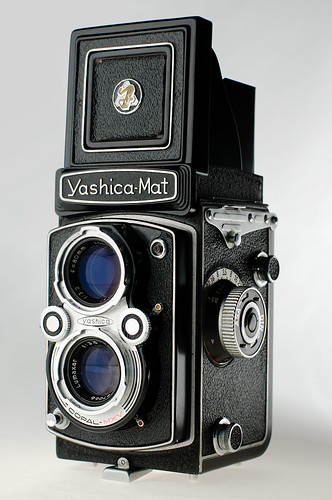
|
| Original Yashica Mat, Lumaxar lenses image by Jeff Rawdon (Image rights) |
Yashica was a Japanese camera maker, founded in 1945 and absorbed into Kyocera in 1983. It notably manufactured 35mm SLR cameras under the Contax brand from 1974 onwards.
Contents
- 1 Company history
- 2 35mm film cameras
- 3 120 film cameras
- 4 127 film cameras
- 5 126 film cartridge cameras
- 6 110 film cartridge cameras
- 7 16mm film cameras
- 8 Minox film cameras
- 9 APS film cameras
- 10 Light meters
- 11 Notes
- 12 Sources / further reading
- 13 Links
Company history
Yashima period
The company was founded in May 1945 as Yashima Seiki Seisakusho (八洲精機製作所, meaning Yashima Precision Works) in the Nagano Prefecture.[1] It first acted as a sub-contractor for other companies, and notably made fuses for gun shells during the last months of World War II.[1] After the war's end, it manufactured components for clock or electric equipment makers.[1] In December 1949, Yashima became the stock company as Yashima Seiki K.K. (八洲精機㈱),[1] whose initial equity was ¥170,000.[2][3]
In early 1953,[4] the company began to make its first camera, the Pigeonflex 6×6cm TLR, on behalf of the distributor Endō Shashin-yōhin.[1][5][6] In June 1953, it changed its name to Yashima Kōgaku Seiki K.K. (八洲光学精機㈱, meaning Yashima Optical Precision Instruments),[1] reflecting its new involvement into the camera business. The same year, the company marketed its first camera under its own brand, the Yashima Flex, another 6×6cm TLR. The Pigeonflex and Yashima Flex were already equipped with Tomioka lenses, beginning a relationship that would last for years.
The Yashima Flex was very soon succeeded by a number of models named Yashicaflex, some of which had semi-automatic winding. In 1956, the company name was changed to Yashima Kōgaku Kōgyō K.K. (八洲光学工業㈱, meaning Yashima Optical Industries).[1] The same year, the inexpensive Yashica Rookie made further use of the Yashica brand, which was constructed from Yashima and Camera, similarly to "Leica", "Konica" and various others.
In 1957, the Yashima company released the Yashica-Mat with crank advance. The same year, it founded Yashica, Inc., its first subsidiary outside Japan, based in New York City to manage marketing efforts in the USA.[1] It also entered the 8mm cine camera market with the Yashica 8T.
Yashica from 1958 to 1973
In 1958, the company became K.K. Yashica (㈱ヤシカ, Yashica Co., Ltd.),[1][7] finally adopting the name of its products. By the time, it had ¥100,000 equity base.[2][8] It expanded into other segments of the market, releasing the Yashica 35, its first 35mm film camera, and the Yashica-44, a 4×4cm TLR strongly inspired by the Baby Rolleiflex, which caused conflicts with Franke & Heidecke.[5] Finally, it acquired the company Nicca Camera, which was making 35mm cameras with focal-plane shutter and went bankrupt in June 1958.[9][10]
In 1959, the former Nicca products were taken over under the Yashica brand with some modifications, the Nicca 33 becoming the Yashica YE and the Nicca IIIL becoming the Yashica YF. The Nicca Camera company itself became the subsidiary Taihō Kōgaku K.K. (大邦光学㈱, meaning Taihō Optical).[1]
For some years, the company had ties with the Konan Camera Laboratory, whose founder Nakamura Gakan trained various Yashica engineers detached for that purpose.[11] A direct result of that cooperation was the Yashica Future 127, a prototype camera taking 4×4cm film presented in 1959, and the first Japanese camera with automated exposure.
Also in 1959, Yashica further diversified into the subminiature market, releasing the Yashica Y16 with a novel system of preloaded cassettes.
The company also established ties with Polaroid, and it released the Japanese made Polaroid Pathfinder 120 in 1960.[1][7] That year, the company's equity base was ¥600,000, multiplied by six in two years.[2] The same year, Yashica also released the Pentamatic, a modern 35mm SLR with specific bayonet-mount interchangeable lenses, capitalizing on Nicca's experience in focal-plane shutters. The proprietary bayonet mount was soon abandoned, and Yashica adopted the popular 42mm screw mount for the 1961 Penta J and later 35mm SLR models. It is said that all the lenses sold under the Yashikor or Yashinon brands were supplied by Tomioka.
In 1961, Yashica released the Rapide half-frame camera, having effectively entered all the possible segments of the market (except for medium-format SLRs). It continued to work on auto-exposure cameras, with the Flash-O-Set and Yashica 35EE so-called "Electric Eye" cameras. Its first camera with electronically controlled shutter was the Yashica Electro Half, launched in 1965, whose shutter was developed by Copal;[12] this was also the first Japanese camera commercially available with an electronic shutter.[12][13] The full-frame Yashica Electro 35 followed in early 1966.[12][14]
In April 1968, the subsidiary Taihō Kōgaku (former Nicca Camera) was merged into the main company,[2] and in August, Yashica also acquired the lens maker Tomioka Kōgaku Kikai,[2] a major company with which it was linked for many years. Sales of 35mm SLRs continued to grow steadily, and Yashica was quickly acquiring a reputation for both electronic camera expertise and high-quality optics. The same year, Yashica launched its first 35mm SLR with electronic shutter, the TL Electro X, and released the Yashica Mat-124, which combined the cumulative improvements of Yashica's earlier TLR cameras.
Yashica and Contax lines
By 1973, Yashica was a production giant with considerable electronic camera experience, and was seeking ways to expand sales and improve brand name recognition in the highly competitive 35mm SLR market. Thus began a collaboration with Carl Zeiss to produce a new, professional 35mm SLR with an electronically-controlled shutter, bearing the Contax brand name.[15] The F. A. Porsche design studio was hired to complete an ergonomic and stylish body shape. The new Contax RTS appeared at the Photokina in 1974, and proved an immediate hit. A new prestige line of Contax/Yashica lenses designed by Carl Zeiss were introduced for the camera, with a new C/Y bayonet mount which was also adopted on the regular Yashica SLR line, allowing lens interchange between all 35mm Contax and Yashica SLR models.

|
| Yashica Y/C bayonet product line brochure scanned by Chasing Classic Cameras with Chris (Image rights) |
Within the Yashica line, the Y/C bayonet mount first appeared on the FX-1 (1975) and FX-2 (1976). Yashica took the opportunity to upgrade and expand its regular line of 35mm SLR lenses, introducing improved optical designs and coating technologies (for the multi-coated ML lenses). The upscale Yashica FR, released in 1977 and partly based on the Contax RTS design, was a manual-exposure, electronically-controlled camera designed to appeal to the semi-professional and serious amateur user, while also capable of using the entire range of Carl Zeiss T* lenses. This practice of ‘pairing’ similar Contax models with more affordable, less full-featured, but still high-quality Yashica models would continue for the next 10 years.
The FR was quickly followed in April 1977 by the FR-I and FR-II. The FR-I had both manual and auto-exposure modes, and was even closer in design and features to the premium Contax RTS. The FR-II was an auto-exposure only SLR designed for a growing market of new photographers who did not want or need full manual metering capability. The FR-I and FR-II reached the U.S. market early in 1978. All of these cameras were on the whole extremely well-designed and manufactured, and even incorporated a few improvements over the RTS. Popular Photography tested the FR in its September, 1977 issue and described the camera as being tougher in some ways and better sealed against dust than its older brother. Along with the ability to mount Carl Zeiss T* lenses, Yashica offered a multitude of Contax/Yashica accessories and power winders for the FR series, competing seriously for the first time in the professional and semi-pro SLR marketplace.
In 1979, Yashica introduced a new inexpensive 35mm consumer SLR, the FX-3, intended for entry-level buyers. Like all Yashica manual-focus bodies, the affordable FX-3 would also accept Carl Zeiss T* lenses. This simple, lightweight manual-exposure SLR camera proved to be an immediate hit with new and experienced photographers alike, and millions were eventually sold. The FX-3 was developed by Yashica and produced by Cosina, a company with a successful history of making cameras for many other camera brands, including Minolta, Olympus, Revue, and Vivitar. In the early 1980s, the compact, mid-priced FX-D and FX-70 cameras were introduced to good reviews. As before, these cameras were derivatives of the current Contax models (139Q and 137MA). The new Yashicas signalled the company's return to its middle-of-the road, moderately priced amateur market.
Into Kyocera
In October 1983, Yashica Company Ltd. was acquired by ceramics giant Kyocera. Initially, the merger resulted in few outward changes. The manual-focus (MF) FX-103 Program, introduced in 1985, continued the ‘pairing’ tradition of high-end Yashica SLR models with Contax (Contax 159mm), and was the first Yashica SLR with TTL flash and full programmed exposure capabilities.
Yashica and Contax models made after 1983 are described in the Kyocera page. In 2005, Kyocera halted production on all Contax, Yashica, and other Kyocera branded film and digital cameras.
35mm film cameras
SLR
Fixed lens
Yashica proprietary bayonet mount
| ||
| ||
| ||
|
- Yashica Pentamatic
- Yashica Pentamatic II
- Yashica Pentamatic S
M42 screw thread mount
- Yashica Penta J
- Yashica J-3
- Yashica J-4
- Yashica J-5
- Yashica J-P
- Yashica J-7
- Yashica Electro-AX
- Yashica TL
- Yashica TL-E
- Yashica TL Electro
- Yashica TL Electro-X
- Yashica TL Electro-X ITS
- Yashica TL Super
- Yashica FFT
For Montgomery Ward Department Store:
- Wards SLR 500 - similar to Penta J with some features of the J-P
- Wards SLR 600 - similar to J-3 with some features of the J-4
Contax/Yashica (C/Y) bayonet mount
Autofocus SLR (Kyocera/Yashica mount)
- 200 AF
- 230 AF
- 270 AF
- 300 AF
Autofocus SLR (half-frame, fixed lenses) by Kyocera
Rangefinder, fixed lens
| ||
| ||
|
- Yashica 35
- Yashica YK
- Yashica 35YL
- Yashica 35YJ
- Yashica Electro 35
- Yashica Electro 35 Professional
- Yashica Electro 35 G (Gold Mechanica)
- Yashica Electro 35 GS
- Yashica Electro 35 GT
- Yashica Electro 35 GSN
- Yashica Electro 35 GTN
- Yashica Electro 35 CC
- Yashica Electro 35 CCN
- Yashica Electro 35 FC
- Yashica Electro 35 GL
- Yashica Electro 35 GX
- Yashica Electro M5
- Yashica Campus
- Yashica 35W
- Yashica EE
- Yashica Minimatic C
- Yashica Minimatic S
- Yashica Minimatic EL
- Yashica Lynx 1000
- Yashica Lynx 14
- Yashica Lynx 14E
- Yashica Lynx 5000
- Yashica Lynx 5000E
- Yashica MG-1
- Yashica M (1960)
- Yashica M3
- Yashica Minister
- Yashica Minister II
- Yashica Minister III
- Yashica Minister D
- Yashica Minister 700
Rangefinder, interchangeable lens
| ||
| ||
|
Viewfinder
- Flash-O-Set
- Flash-O-Set II
- Yashica ME 1
- Yashica 35 MF
- Yashica MF-1
- Yashica MF-2
- Yashica MF 2 Super
- Yashica MF-3
- Yashica 35-ME
- Yashica Electro 35 MC (zone focus)
- Yashica Diary
- Yashica Flasher
- Yashica Partner
- Yashica Partner Autofocus
- Yashica Auto Focus series (S, Motor, Motor-D, AF-M II)
- Yashica AF-j
- Yashica AF-J2
Half-frame Viewfinder
- Yashica Rapid / Rapide
- Yashica 72-E
- Yashica Mimy / Mimy S
- Yashica Sequelle
- Yashica Half 17
- Yashica Half 17 Rapid
- Yashica Half 17 EE Rapid
- Yashica Electro Half
- Yashica Half 14
120 film cameras
6×6 TLR
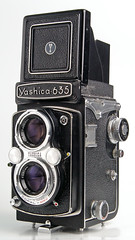
|
| Yashica-635 image by Martin Taylor (Image rights) |
- Pigeonflex (original model)
- Yashima Flex
- Yashica Flex B
- Yashicaflex A, B, C, S, AS
- Yashica Rookie
- Yashica LM
- Yashica-A
- Yashica-B
- Yashica-C
- Yashica-D
- Yashica-E
- Yashica-635
- Yashica-Mat
- Yashica-Auto
- Yashica-Mat LM
- Yashica-Mat EM
- Yashica-12
- Yashica-24
- Yashica Mat-124
- Yashica Mat-124G
127 film cameras
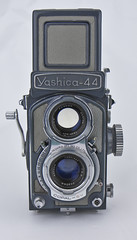
|
| Yashica-44 image by Christopher Robin Roberts (Image rights) |
4×4 TLR
4×4 rigid
126 film cartridge cameras
- Yashica EZ-matic
- Yashica EZ-matic Electronic
- Yashica EZ-matic 4
- Yashica Minipak
110 film cartridge cameras
- Yashica Electro 110
- Yashica Palmatic 20
16mm film cameras
Minox film cameras
APS film cameras
Light meters
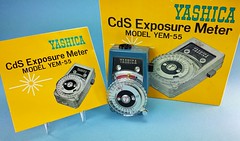
|
| Yashica YEM-55 image by yashicasailorboy (Image rights) |
- YEM-31
- YEM-31 Super
- YEM-35
- YEM-35 Super
- YEM-55
Notes
- ↑ 1.00 1.01 1.02 1.03 1.04 1.05 1.06 1.07 1.08 1.09 1.10 Sakai, p.6 of Kurashikku Kamera Senka no.26.
- ↑ 2.0 2.1 2.2 2.3 2.4 Sakai, p.7 of Kurashikku Kamera Senka no.26.
- ↑ A previous unsourced version of this page says that the company had eight employees by the time.
- ↑ Dates of the earliest advertisements and articles listed for Yashima's Pigeonflex in Kokusan kamera no rekishi, p.360.
- ↑ 5.0 5.1 Shibano, p.8 of Kurashikku Kamera Senka no.26.
- ↑ Kyōshū no burando ten, p.10.
- ↑ 7.0 7.1 Shibano, p.9 of Kurashikku Kamera Senka no.26.
- ↑ A previous unsourced version of this page says that the company had 1,982 employees by the time.
- ↑ Lewis, p.104.
- ↑ A previous unsourced version of this page said that the company also absorbed Zunow in 1960 or 1961, but this was surely a mistake.
- ↑ Shirai, pp.61–2 of Maboroshi no kamera o otte.
- ↑ 12.0 12.1 12.2 Shibano, p.10 of Kurashikku Kamera Senka no.26.
- ↑ The first cameras in the world with electronically controlled shutter were the Polaroid 100 and the Japanese Artronic prototype, both presented at the 1963 Photokina. (Lewis, p.118.) A previous unsourced version of this page said that the world's first electronically controlled 35mm camera was the Yashica Electro 35, but this is definitely a mistake.
- ↑ A previous unsourced version of this page says that 5 million units of the Electro 35 were eventually sold, but this is unconfirmed.
- ↑ A previous unsourced version of this page says that this collaboration was called ‘Top Secret Project 130’.
Sources / further reading
- Asahi Camera (アサヒカメラ) editorial staff. Shōwa 10–40nen kōkoku ni miru kokusan kamera no rekishi (昭和10–40年広告にみる国産カメラの歴史, Japanese camera history as seen in advertisements, 1935–1965). Tokyo: Asahi Shinbunsha, 1994. ISBN 4-02-330312-7.
- Lewis, Gordon, ed. The History of the Japanese Camera. Rochester, N.Y.: George Eastman House, International Museum of Photography & Film, 1991. ISBN 0-935398-17-1 (paper), 0-935398-16-3 (hard).
- Nihon no kamera o omoshiroku shita kyōshū no burando ten (日本のカメラを面白くした郷愁のブランド展, Exhibition of nostalgic brands that made Japanese cameras interesting). Tokyo: JCII Camera Museum, 1997. Exhibition catalogue; pp.11 profile seven Yashima/Yashica cameras.
- Sakai Shūichi (酒井修一). "1945–1983. Yashika gairyakushi." (ヤシカ概略史, Yashica abridged history). In Kamera Rebyū: Kurashikku Kamera Senka (カメラレビュー クラシックカメラ専科) / Camera Review: All about Historical Cameras no.26, September 1993. No ISBN number. Yashika Kyōsera Kontakkusu no subete (ヤシカ・京セラ・コンタックスのすべて, special issue on Yashica, Kyocera and Contax). Pp.6–7.
- Shibano Daisuke (柴野大輔). "Tasai ni tenkai suru mittsu no burando: Yashika, Kontakkusu, Kyōsera no kamera" (多彩に展開する三つのブランド・ヤシカ、コンタックス、京セラのカメラ, Three brands developing in various ways: Yashica, Contax and Kyocera). In Kamera Rebyū: Kurashikku Kamera Senka (カメラレビュー クラシックカメラ専科) / Camera Review: All about Historical Cameras no.26, September 1993. No ISBN number. Yashika Kyōsera Kontakkusu no subete (ヤシカ・京セラ・コンタックスのすべて, special issue on Yashica, Kyocera and Contax). Pp.8–11.
- Shirai Tatsuo (白井達男). "Yashica Futura 127". Pp.57–66 of Maboroshi no kamera o otte (幻のカメラを追って, Pursuing phantom cameras). Gendai Kamera Shinsho (現代カメラ新書). Tokyo: Asahi Sonorama, 1982. ISBN 4-257-08077-9. (First published in Kamera Rebyū / Camera Review. no.7, May 1979.) On the ties between Yashica and Konan.
- Peter Dechert. The Contax Connection. Historical Camera Publications, 2007. Available for download in PDF at Peter Dechert's Corner (includes relevant informacion about Yashica cameras]
Links
In English:
- Yashica SLR Pages (archived)
- The Yashica Guy
- The unofficial Yashica old SLR homepage (archived)
- The Yashica Forum
- The unofficial Contax & Yashica User Forums - English and German (archived)
- User manuals for many Yashica SLR, rangefinder and Yashica MAT cameras 35mm and 2¼ cameras. Manuals in PDF and some in HTML format that can be translated. A few Yashica Mat exploded views available.
- Yashica TLRs
- Yashica Cameras Price Guide at CollectiBlend
- Yashica/Kyocera cameras list (archived) by Captainchaoz
- Yashica Camera Manuals :: Photo-Manuals.com
- Yashica Mat-124 and Yashica J-7at Classic Cameras by RaúlM.
- Yashica camera's in Andrys Stienstra's camera collection
In French :

